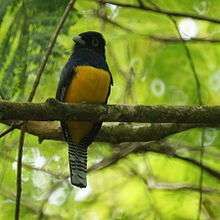Guianan trogon
The Guianan trogon (Trogon violaceus), is a near passerine bird in the trogon family, Trogonidae. It is found in humid forests in the Amazon basin of South America and on the island of Trinidad. Until recently, this species, the gartered trogon (T. caligatus) of Mexico, Central America, and northern South America, and the Amazonian trogon (T. ramonianus) of the western Amazon were all considered to be conspecific and collectively called violaceous trogon.
| Guianan trogon | |
|---|---|
 | |
| Scientific classification | |
| Kingdom: | Animalia |
| Phylum: | Chordata |
| Class: | Aves |
| Order: | Trogoniformes |
| Family: | Trogonidae |
| Genus: | Trogon |
| Species: | T. violaceus |
| Binomial name | |
| Trogon violaceus Gmelin, 1788 | |
Behavior
It is a resident of moist tropical forests, where it nests in a wasp, ant or termite nest or a hole in a rotten tree, with a typical clutch of two or three white eggs.
Guianan trogons feed on insects and small fruit, and their broad bills and weak legs reflect their diet and arboreal habits. Although their flight is fast, they are reluctant to fly any distance. They typically perch upright and motionless.
Description
Trogons have distinctive male and female plumages, with soft, often colourful, feathers. This relatively small species is about 23 centimetres (9.1 in) long and weighs 56 grams (2.0 oz). The head and upper breast of the male are blue and the back is green, becoming bluer on the rump. A faint white line separates the breast from the orange yellow underparts. The undertail is white with black barring, and the wings are black, vermiculated with white. The complete eye-ring is yellow. The female violaceous trogon resembles the male, but has a dark grey back, head and breast, and an incomplete white eye-ring.
This species resembles the white-tailed trogon, but the latter is larger and has a complete pale blue eye-ring in both sexes. Furthermore, the male white-tailed trogon lacks barring to the undertail.
The shade of the blue of the head in the male differs between the Guianan trogon and the gartered trogon, but (disregarding their separate distributions) the call is the main distinction between the two. The gartered has a slurred whistled cuh-cuh-cuh, and the Guianan has a soft cow cow, cow.
References
- BirdLife International (2004). "Trogon violaceus". IUCN Red List of Threatened Species. 2004. Retrieved 6 May 2006.CS1 maint: ref=harv (link)
- South American Classification Committee (2008). Recognize Trogon caligatus as a separate species from Trogon violaceus (2).
- ffrench, Richard (1991). A Guide to the Birds of Trinidad and Tobago (2nd ed.). Comstock Publishing. ISBN 0-8014-9792-2.
- Hilty, Steven L (2003). Birds of Venezuela. London: Christopher Helm. ISBN 0-7136-6418-5.
- Gill, F and D Donsker (Eds). 2011. IOC World Bird Names (version 2.10). Available at http://www.worldbirdnames.org/ [Accessed 15 November 2011].
